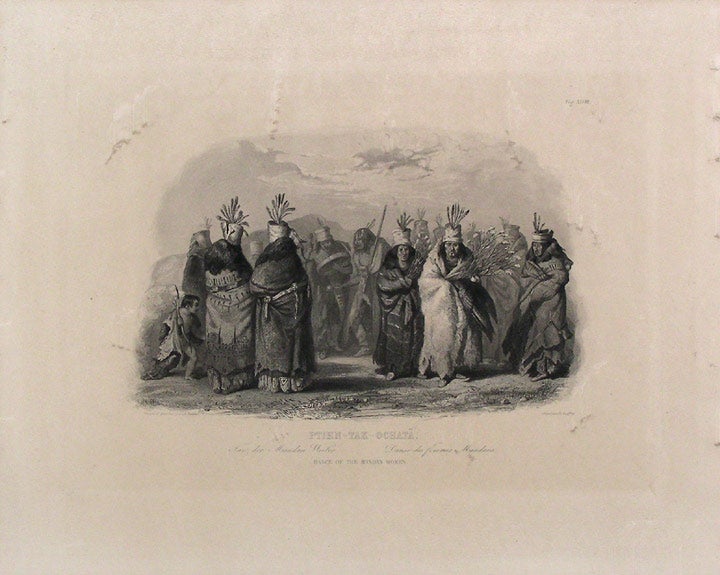BODMER, Karl (1809-1893)
Ptihn-Tak-Ochatä. Dance of the Mandan Women.
[Vig. 28] [Leipzig: Schmidt and Guenther, 1922]. Aquatint engraving by L. Weber after Bodmer. Sheet size: 12 1/2 x 15 3/4 inches.
From the scarce Leipzig edition printed from the original copper-plates. Limited in number, the prints from the Leipzig edition are more scarce than, and compare favorably to, the first edition. (David C. Hunt, "Karl Bodmer and the American Frontier," Imprint/Spring 85, p.18)
The dance of the women of the Mandan White Buffalo Cow Society was performed for the factor and his guests at Fort Clark on 25 December 1833. Bodmer and Prince Maximilian overwintered at Fort Clark, between the Knife and Heart Rivers in the territory of the Mandans and the Hidatsas, and made full use of their time to record in detail the life, history and beliefs of the Indian Tribes around them. Both the Mandans and the Hidatsas were divided into a series of age-graded societies into which a person successively purchased membership as he or she got older. The White Buffalo Cow Society was one of four such amongst the women of the Mandan, and they had special hats made of rectangular pieces of the rare and sacred white buffalo hide. These were wrapped around the head and laced at the back with a plume of owl or at the front with raven feathers. Karl Bodmer's images show great versatility and technical virtuosity and give us a uniquely accomplished and detailed picture of a previously little understood (and soon to vanish) way of life. Swiss-born Bodmer was engaged by Prince Maximilian zu Wied-Neuwied (1782-1867) specifically to provide a record of his travels in North America, principally among the Plains Indians. In the company of David Dreidoppel (Prince Maximilian's servant and hunting companion), their travels in North America were to last from 1832 to 1834. They arrived in Boston in July 1832, traveled on to Philadelphia, where they stayed with Napoleon Bonaparte's elder brother Joseph. From here they headed west across Pennsylvania across the Alleghenies to Pittsburgh and the Ohio country, visiting all the important German settlements en route. Their most important stop on their route west was at the utopian colony of New Harmony in Indiana. The Prince spent five months there in the company of some of the country's leading scientific men, and studying all the relevant literature on backcountry America. On 24 March 1833 the party reached St. Louis, Missouri, and the start of the journey into Indian country.
David C. Hunt, "Karl Bodmer and the American Frontier," Imprint/Spring 1985, p.18. Cf.Graff 4648; cf. Howes M443a; cf. Pilling 2521; cf. Sabin 47014; cf. Wagner-Camp 76:1.
Item #20075
Price: $500.00


